Historic Detroit
Every building in detroit has a story — we're here to share it.
Fisher Building

By Dan Austin of HistoricDetroit.org
The building known as “Detroit’s largest art object" has been dropping jaws in New Center for more than 90 years.
The Fisher -- built by the Fisher brothers of “Body by Fisher" fame -- opened in September 1928, at Second Avenue and Grand Boulevard. Once known as the Cathedral to Commerce, the 441-foot tower is decked to the nines in fancy marbles, mosaics, soaring, painted ceilings and a whole lot of brass and bronze. This world of shops, theater, art and architectural beauty is renowned architect Albert Kahn's masterpiece, “a superbly designed complex which displays some of the finest craftsmanship in any Art Deco style building constructed in the U.S. in the 1920s," the National Park Service says.
Unquestionably, the golden tower of the Fisher Building is one of the most recognizable sights in Detroit’s skyline.
A beauty is born
Like so much of Detroit’s history, the Fisher Building is tied to the automobile industry. The Fisher brothers -– Frederick J., Charles T., William A., Lawrence P., Edward F., Alfred J. and Howard A. -– made a fortune making auto bodies for Detroit’s booming car industry. From the days in their boyhood home in Norwalk, Ohio, the brothers learned from their parents -– carriage maker Lawrence Sr. and Margaret -– to work and play together, a mentality of one for all and all for one. Their bond was strong. They arrived in Detroit in 1908 and formed the Fisher Body Co. Their timing was impeccable: Their business was founded just three months before the birth of General Motors Corp.
They were responsible for creating the closed body chassis for Cadillac in 1910. This development not only transformed the automobile from a pleasure vehicle into the indispensable, world-changing, all-weather, year-round form of transportation it is today, it also transformed the brothers into filthy rich businessmen. They had started the business with $50,000 (about $1.2 million today), and GM bought them out just 18 years later, in 1926, for $208 million (a staggering $2.5 billion today). The brothers also introduced the first four-door sedan bodies. They sold 60% interest in their company to GM -- giving Fisher exclusive supplier status -– in 1919, and the rest of the 40% in 1925, for a reputed $208 million. They made large investments in oil, railroad and aviation equipment, banking and real estate.
But unlike many Detroit millionaires of today, the Fisher brothers often used their wealth to better the city and its people. They gave millions to countless charities, civic causes, churches, educational institutions, and to making Detroit one of the finest cities in the world.
To that end, the Fishers commissioned Kahn in 1927 and essentially told him to go wild. Simply put, the Detroit News wrote in 2001, the brothers told the architect to build them “the most beautiful building in the world" and that quality would not be sacrificed in order to save money. It was an architect’s dream project.
The brothers wanted more than just an office tower to serve as the company’s headquarters, they wanted the building to also serve as a center for shopping and entertainment. The brothers did not plan on profiting from the building, rather they viewed it as a gift to Detroit. A Free Press headline in January 1927 referred to it as the brothers’ "huge testimonial to their faith in Detroit."
Or, as the Michigan Manufacturer and Financial Record simply put it in October 1928, the Fisher is a building “into the making of which money has been literally flung with a generous hand, not merely for the sake of spending it, but to gratify the desire of the owners to give such an example of architectural and cultural elegance as will constitute an outstanding claim to its permanent inclusion in the list of the most important structures of the country."
Twenty years earlier, the Fishers were neither wealthy nor famous. Now, they were loaded, known around the world and would have a beautiful, soaring skyscraper to prove it.
Rising up uptown
At the time, real estate in downtown Detroit was expensive -- especially when you needed as much land for a building the size of the Fisher. And even if money were no object, just finding enough land for such a project was no easy feat. Because of this, a second downtown – New Center, as it would come to be known -- had started sprouting about 1915 in an area 3 miles north of Campus Martius. The first major building in New Center was the Kahn-designed General Motors Building, and it served as the automaker’s headquarters. The building, today known as Cadillac Place, had already introduced a considerable amount of business activity to the area. The Fisher brothers became the first tenant in the General Motors Building when it was completed in 1920.
The brothers had tried to buy a downtown block on Woodward Avenue, but couldn’t secure the rights to enough parcels for the project, so they decided to build their monument in New Center. For the first time, Fisher Body's board of directors, staff, advisers and offices would be all under one roof.
Fred Fisher, being the oldest of the brothers, announced on Jan. 15, 1927, that they had bought 32 parcels of land on the block bounded by West Grand Boulevard, Lothrop Road and Second and Third avenues -– 332,000 square feet. More than $30 million ($373 million today, when adjusted for inflation) was to be spent to erect a sprawling three-tower complex that would “serve as an expressive testimonial of the Fishers’ activity in Detroit," the Detroit Free Press reported at the time. While only one of the three spires would be built -– more on that later on -– the Fisher brothers still spent $9 million ($116.5 million today) on the present day Fisher alone, excluding the cost of the theater. Of that, it has been said that 25% -- about $29 million today -- went to art and decoration of the building.
“Detroit was startled some years ago when General Motors decided to erect its mammoth office building on Grand boulevard," Fred Fisher told the Free Press at the time. “This structure, which has attracted the attention of the entire world, is now past history, but it has seen this section develop into an important one commercially."
Other reasons cited for building so far north of downtown included escaping the hassle of traffic congestion, and the fact that “this section is, as a matter of fact, from a geographical standpoint and elapsed time in traveling point, the very heart of Detroit," Fred Fisher said. That is, the Fisher is located about smack-dab in the middle of town, so it’s about the same distance from almost anywhere in the city.
The entity behind the plan was the New Center Development Corp., a subsidiary of Fisher & Co. Inc., which was in turn owned and controlled by the Fisher brothers.
Fred Fisher -- because he was the oldest brother -- turned the first shovel of dirt at the Aug. 23, 1927, groundbreaking ceremony, which was also attended by Gov. Fred W. Green and Mayor John W. Smith. That event was the beginning of what would be an enormous undertaking. The recipe called for more than 12,000 tons of steel; 350,000 cubic yards of concrete and marble; 1,800 bronze windows; 641 bronze elevator doors (inside and outside of the cars); 420 tons of bronze finishings; 46,000 square feet of concrete forms, 41,000 barrels of cement, 100,000 yards of sand and gravel and 1,275 miles of electrical and telephone wire and cable. With more than 325,000 square feet of exterior marble, the Fisher is the largest marble-clad commercial building in the world.
Still, construction took only 15 months, and by December 1928, the Fisher was 60 percent occupied -- an astonishing feat considering the level of craftsmanship and the sheer size of the place: The Fisher’s 441-foot tower is a flanked by two 11-story, flat-roofed wings and weighs in with 1.134 million square feet of floor area. Of that, however, only 463,000 square feet are usable for offices, with the arcade and 14-foot and 18-foot corridors eating up much of the square footage. The Fisher was also a symbol of Michigan's might: It was designed by a Detroiter and built by Michigan contractors and workers.
The Michigan Manufacturer and Financial Record wrote in October 1928 that "from many angles of consideration, the new Fisher Building is the most distinctive piece of modern construction in Detroit and Michigan. As a matter of fact, it is at present time the most thoroughly discussed building among architects and builders in the United States. It has already begun to achieve national distinction."
Kahn may be honored today as a visionary, but he was far from a radical of his time. In his seminal book “The Buildings of Detroit," W. Hawkins Ferry writes that Kahn “viewed with alarm much that went under the name of modern architecture" and “was determined to proceed with caution in the design" of the Fisher. “He recognized that the modern skyscraper deserved an exterior treatment expressive of its structure, but he was wary of any indulgence in the strange or the bizarre, both of which he felt were too often mistaken for originality."
Kahn wrote in a periodical during the time that “there is a certain appeal to many in what is strange and what seems new to them. In architecture, to be worthy of a title there must ever be dignity and good taste, neither acrobatics nor wild orgies. The architect’s responsibility is indeed great and should prove a deterrent in erecting structures which at best are but an experiment, often proving a failure. We architects may build in our own back yard anything as ugly and curious as we please, but we have no right to do this for clients who rely on us to create that which will withstand the test of time."
Few can dispute that the Fisher Building would do just that.
Big and beautiful
The late 1920s were a time of unprecedented growth in Detroit, especially when it came to skyscrapers. From the Penobscot Building to the Fox Theatre , 1928 saw landmark after landmark rise in the Motor City.
"The gold-capped tower has taken its proper place in Detroit's ever-changing skyline," the Detroit News wrote of the Fisher in October 1928, when the finishing touches were being put on the building. "This will be the most beautiful building of its kind ever created. ... It is an outstanding example of the new American school of architecture, which has arisen to typify the spirit of modern progress. No expense, Mr. Kahn said, has been spared to make the Fisher building the very epitome of things beautiful."
To achieve this feat, the Fisher was built -- with only slight exceptions -- entirely out of granite and marble, including on the exterior. More than 40 kinds of marble from all over the world were used. From the base of the building to 50 feet up -- the first three floors -- the exterior is finished in polished Minnesota pink marble and Oriental granite. Above that is Beaver Dam marvilla marble (named such because it was harvested from the Beaver Dam Quarry at Cockeysville, Md.) on the street fronts and Carthage marble on the courts. The marble was cut and positioned to give varying textures across the exterior. "The sun (plays) on differences of saw markings and grain on each block that identify the individual pieces from their neighbors," the Michigan Manufacturer and Financial Record wrote in October 1928.
"The problem of handling great facades with a multiplicity of windows was solved by breaking the planes into panels by recession of the wall surfaces," Ferry wrote. "The transition from the 11-story wings of the Fisher Building to the 28-story tower was gracefully accomplished by a series of setbacks that produced a tapering effect. … It was inevitable that such an overpowering masonry mass, with its strong vertical emphasis and soaring silhouette, should have suggested the Gothic. Although the first studies indicated a flat roof, there was an irresistible temptation to crown the building with a steep pyramidal roof characteristic of Gothic structures."
Up until this point, Kahn had decorated most of his interiors in more traditional styles with classical or renaissance details. The Fisher marked a departure of sorts. While far more modest than the Guardian Building's interior, the Fisher was far more modern for its time than Kahn's past works. Most of the artwork and decoration reflects American culture -– commerce, transportation, art and agriculture are all represented throughout. For the sculpture, mosaics and frescoes, Kahn turned to Geza R. Maroti, an artist from Budapest, Hungary. Maroti was a leader in his nation's art movement, and Hungary entrusted him to prepare foreign exhibitions and decorate the buildings for them. He also was associated with Eli Saarinen and working at the renowned Cranbrook Schools in Bloomfield Hills.
Maroti packed his work in the Fisher with symbolism, focusing mostly on two ideas: The wealth and power of the United States expressed through commerce and transportation, and American culture and civilization through music and drama. The eagles with their wings slightly open, ready to take flight, symbolize an America ready to advance to greater things. Other eagles in and on the Fisher have their wings outstretched, symbolizing the power of the United States. Those with their wings tucked in, in a sheltering manner, show the nation's strength and that it is sound. The victorious eagles of Zeus, with their wings spread against a purple background, hover above the entrance to the theater. They echo those that flew above the conquering armies of Greece. They signify the dedication of theater to high ideals, the genius and freedom of creativity and art and the progress of drama.
The style and hemlock motif was something from Hungarian tradition that Maroti brought over from Central Europe but modern for America at the time.
The elaborate frescoes were also designed by Maroti but carried out by artists Antonio and Tomas de Lorenzo of New York City. The painters stood atop massive scaffolds to give the arcade the right touch Kahn sought. More than $20,000 (about $265,000 today) went into the fresco work alone, covering the ceiling in gold leaf and endless oil color. Marotti produced each piece of decoration in full size cartoon form before it was painted on the ceiling by the de Lorenzos. Amazingly, it took only two months to hand-paint the arcade's huge canvas. Making the effort even more impressive was Marotti's biggest challenge: He had to make the ceilings as stunning from the ground as they were from the third-floor galleries. No easy trick.
Of its three-story lobby's hand-painted barrel-vaulted ceilings, the News wrote that "the ceiling is a mass of gorgeous color, shimmering like the plumage of exotic birds." The Michigan Manufacturer and Financial Record said "no business building in America ... has been so lavishly decorated in a barbaric wealth of color." The ceiling features a flora and fauna theme and is covered in redheaded cherubs and muses frolicking among hemlock and evergreen needles. Custodians would use gallons of buttermilk to wash the ceiling.
Along the walls of the arcade are 26 lunettes with symbolical designs and subjects such as Agriculture, Art, Justice, Knowledge, Music, Navigation, Peace and Thrift.
Among the painted ceilings are words painted along the arches. The arch on the southern arch says, "The drama's law the drama's patrons give. For we that live to please must please to live." It is by 18th century author Samuel Johnson's prologue to celebrate new management of London's Drury Lane Theatre in 1747. On the other side of the southern arch, it says: "To wake the soul by tender strokes of art, to raise the genius and to mend the heart." These words are by Alexander Pope, part of a prologue to Joseph Addison's play "Cato" in 1713.
The three-story arcade is finished entirely in marble -- mostly Carthage marble -- except for the ceilings and three mosaic tile decorations. There are fluted marble pillars, each in a different color but still "in perfect harmony," the Detroit News wrote in October 1928. The floors are vari-hued Italian marble in warm tones of rose, light browns and creams. They are similar in design to the floors of many churches in Rome, which Kahn often cited as in influence on his work. The floors of the second- and third-floor concourses are Tennessee marble; their walls are polished European marble.
The Fisher had shops on the first three floors, both along the arcade and along the streets.
The mosaics are near the center of the arcade, where the north and west halls meet. Nearly 10 feet tall with an arched top, the mosaics are in gold, blues, grays, greens, oranges and siennas. One features birds of paradise sitting on a hemlock branch, echoing the hemlock covering the ceiling. The other two features eagles with outstretched wings – one on a tree of life; the other on hemlock.
Nearby, set into the floor, is a large bronze shield in low relief. It featured a semi-nude figure of Mercury -- the god of transportation and bearer of messages -- running. Around the shield are inlaid marble in warm browns, creams and reds. The four principal bronze inlays are semi-nude figures symbolizing the four elements of the ancient world: air, earth, fire and water. Sadly, the details have been mostly eroded by decades of Detroiters trodding over it. It has been roped off to prevent further damage.
The corridors on every floor are marble-faced with cove ceilings. The window sills are marble. The building is also decked out in bronze details everywhere you look. All of the hardware on every window and sash was bronze. The radiators are recessed behind bronze grilles. There were plaques and bronze floor work by Anthony Di Lorenzo, who also did the cast bronze elevator doors. "Because of the diversity of its functions, and the lavish hand with which the littlest perfection was pursued and captured, (the Fisher) becomes for many the ready expression of Detroit's golden age. It is not the consummation of a dream, but the beginning of one," the Detroit News wrote. "Even such a detail as door checks are concealed so that no unsightly bit can mar the beauty of the whole," the News noted. It is highly unlikely today that a client would even think about investing so much money in decoration, especially in an office building.
To ensure that the Fisher brothers' suite near the top of the tower was top shelf, they hired Charles Bacon of the well-known firm William Wright Co. as their interior decorator. Their 26th-floor reception room was often called the world's most exclusive club and the most lavishly furnished office space in the world of business," the News wrote. The 25th through 27th floors had a dining room, kitchen, living room and private elevator. It was outfitted with Persian rugs, massive hand-carved desks, rich walnut paneling, bronze chandeliers and scrolled plaster ceilings. It was the site of daily informal family meetings, which the brothers combined with lunch every workday at 12:45 p.m.
In 1928, the Architectural League of New York awarded Kahn a Silver Medal for the most beautiful commercial building erected that year.
"In this, his latest creation, Albert Kahn Detroit architect with an international reputation, has set his peg of excellence very high in the contest for the achievement of a purely American style, and has for the moment at least, surpassed all his fellow-contestants in the production of beauty," the Michigan Manufacturer and Financial Record wrote in October 1928.
Still, Kahn was not without his critics.
The architect "was too preoccupied with images of the past to be able to make a crisp, clear statement in contemporary commercial architecture," Ferry wrote.
Architectural critic Sheldon Cheney wrote at the time that "the monumental Fisher Building in Detroit is … softened, anticlimaxed" by its sloping roof. "The boldness of the block forms is so much an asset, so clearly an appropriate machine-like element, that the sloping roof can only serve to weaken the effect – if not to make the whole as ridiculous as a naked man under a hat."
That's not to say Ferry wasn't a fan of the Fisher: Noting the splendor of the arcade, he wrote that the marble walls "would dazzle even the most jaded Roman emperor."
The Detroit Times announced the lighting of the tower in November 1928, to mark the opening of the Fisher Theatre inside the building, that "Detroit's night skies are studded by a new jewel of light. … The great Fisher Tower is ablaze with light. … It presents a startling spectacle." The paper went on to predict that the Fisher Building would be to Detroit "what the Eiffel Tower is to Paris." The News wrote in January 1927 that the Fisher was to the Motor City as Radio City is to New York City.
The building got its nickname of the Golden Tower because it was originally covered in gold-leaf faced tile. But during World War II, it was feared that the glistening tower would become a target for bombings, so it was covered with an asphalt material. After the war, the asphalt couldn't be removed without damaging it, so it was replaced with green terra cotta tile.
Big dreams, with dreams for something bigger
The L-shaped landmark was originally supposed to be a three-building complex and the largest commercial building in the world. There was to have been a taller, 60-story central tower flanked by the current 29-story Fisher Building on the right and an identical tower on the left. This is why the tower of the Fisher Building is aligned to the far right instead of centered. The Great Depression, which hit the year after the building opened, shelved the grand plans to build the other two towers. The mammoth arcade that stretches from Grand Boulevard to Lothrop and Second to the west was originally to bisect the entire length of the three-building complex that was to extend all the way to Third Avenue.
Instead, the Fisher brothers had Kahn design the New Center Building at Second Avenue and Lothrop. Work was originally going to start on the building in 1931, but they moved work on it up to 1930 to help ease the effects of the Depression by putting Detroiters to work. The decision was meant to express the Fisher brothers' unshakeable confidence that "the industrial and financial importance of this city will constantly increase," the Free Press wrote. The building, completed in 1931, is known today as the Albert Kahn Building , named after its maker. The Fisher, New Center and General Motors buildings were all joined together by a series of underground passageways lined with shops. These tunnels are still open today, though many of the storefronts are not in use.
Going up - way up
The skyscraper owes as much to elevators as it does steel. After all, a luxury office 400 feet up wouldn't be such a luxury if you had to scale the stairs. And, like the rest of the building, the Fisher's elevator was also an innovation in its time as it was "automatically controlled in every way," the News marveled. At the time, most elevators in the city still used elevator attendants. And it was fast. Its express elevators ran as fast as any in the world - 800 feet per minute. While that pales in comparison to the 3,314 feet per minute of those in Taiwan's Taipei 101 tower, the Fisher offered quite a thrill ride for Detroiters in 1928.
Changing the way people parked
Kahn not only helped revolutionize the way the world built its factories, he also changed the way it parked its cars. With the rise of the automobile -- and with land values still high in Detroit -- parking was at a premium in the Motor City.
The Fisher was built with an 11-story parking garage in the rear with room for 1,100 automobiles. The garage was attached to the building, so tenants who worked on the first 11 floors were afforded the then-luxury of parking on the same floor as their offices. But the real innovation was the garage’s ramp system, which was worked out at the General Motors Proving Ground. Kahn implemented a double helix design that allowed cars to go down and up on the same ramp at the same time. Today, most garages use this technique, but at the time, Kahn's garage was groundbreaking.
The dedicated garage also helped the Fisher keep tenants in the 1940s and '60s as more metro Detroiters moved to the suburbs and commuted into work. By 1950, 90% of Americans used a car to get around, so parking was essential to most office buildings' success.
Going to the show
The Fisher Building also houses a theater that offers off-Broadway productions. It opened to the public on Nov. 16, 1928, several weeks behind the rest of the building.
In what was a rather new practice at the time, the theater was rather detached from the entrances to the building. This allowed for the Fisher Building's arcade to effectively serve as the foyer for the theater at night and a business passageway by day. It also allowed for the theater to be approached from any of the building's four entrances or the garage.
The theater -- designed by the Chicago-based architectural firm of Anker S. Graven & Arthur G. Mayger -- originally sat about 3,000 people and had an exotic Mayan temple theme in gold and ivory, complete with tropical trees and plants in the lobby and macaws that patrons could feed by hand. Banana trees filled the foyer, and turtles and goldfish filled a pond. Mayan statues flanked the stairs, and the theater had hieroglyphic-like figures around the top of the ceiling. The over-the-top design was meant to evoke a sense of wonder in moviegoers. In the 1920s, especially after the discovery of King Tutankhamen's tomb in Egypt, the United States was obsessed with ancient civilizations, and many of movie palaces going up at the time took on the feel of such temples, the Fox and Fisher included. The Michigan Manufacturer and Financial Record called the theater "a tribute to the life and times of a vanquished people." The theater's seats were described as "golden olive" and upholstered in velvet.
Its stage was large enough to accommodate most any size production, including grand operas. The Fisher Theatre’s arrival on the scene was in many ways spelled the end of older, smaller theaters.
In the early 1930s, the Fisher was run by the Paramount-Publix chain, but it also hosted stage productions. But these weren't "stage shows" as we think of them today, like musicals or dramas.
"It was a movie palace, and like all deluxe movie palaces featured a varied program featuring stage acts, dancing numbers by the resident company, occasional big name headliners, and other touring acts that were the last gasp of vaudeville—all accompanied by the large orchestra and organ," theater historian John Lauter said. "The orchestra and organ would have their own solo spots in the show. To this was added short film subjects, newsreels, and then the feature film. It’s a style of presentation that has been extinct for so long, it’s hard for today’s readers to understand."
However, by the 1950s, the Fisher was showing only movies. But as television stole audiences away from movie palaces, the Fisher Theatre began to struggle, showing films to far-from-full houses. For the last few years of the 1950s, it began showing second-run cinema. The final movie to screen there was "The Magnificent Seven" in 1960.
In 1961, the Nederlander family – a well-known figure in the Detroit theater business – took over the Fisher Theatre. Working with Lawrence P. Fisher, the Nederlander Theatrical Corporation stripped the venue of its temple theme and replaced it with a far tamer, more modern look designed by the firm Rapp & Rapp. The theater's original 3,500 seats were cut to 2,089. Dark woods and earth toned marble was used, and a large bronze sculpture of a female figure on a white marble pedestal was added to the lobby. The theater would now show only legitimate theater. The renovation helped keep the theater alive, giving "an injection of glamour," the Detroit Free Press Magazine noted in September 1966. Marble, wood, bronze and crystal done in a modern style were accented by a gold, white and walnut touch. The cost of the renovation was nearly $4 million. Lawrence Fisher died about a month before the theater reopened to the public on Oct. 2, 1961.
Ferry wrote in "The Buildings of Detroit" that “the Fisher Theater was the last of the great movie palaces to be built in Detroit. These great temples of amusement were the product of the prosperity and ebullience of the period that immediately preceded the Great Depression." Speaking of the remodeling job of 1961, Ferry wrote that thanks to the Fisher brothers’ “enterprise and civic pride, it became the most elegant and luxurious legitimate theater ever seen in Detroit. Thus an old era had ended and a new one begun."
The Fisher's mighty Wurlitzer, which had been used before shows until the end, was removed ahead of the makeover in 1960 by buyer George Orbits and friends. It was first installed in the Iris Theatre on East Grand Boulevard, where it remained playable by the Detroit Theater Organ Society into late 1961. In 1963, the group bought the vacant Senate Theatre on Michigan Avenue in Southwest Detroit at tax auction for $1,000, and spent $25,000 and a year renovating the building and installing the organ. The Fisher's Wurlitzer premiered in its new digs in April 1964, where it remains in use today.
The Fisher brothers let her go
On Dec. 7, 1962, it was announced that the Fisher and the 11-story New Center Building – now known as the Albert Kahn Building – were sold for about $15 million ($106.9 million today) by the four surviving Fisher brothers to a Detroit real estate partnership headed by prominent investors Louis Berry and George D. Seyburn. It was one of the biggest real estate transactions in Detroit history at the time. The two also owned the David Stott Building and a number of hotels from New York to Wisconsin to Florida, including, up until 1955, the Wolverine Hotel in Detroit. Berry was a 59-year-old hotel magnate and philanthropist. Seyburn was a 52-year-old builder. The two men were partners in the International Hotel Corp. of Detroit. Detroit financier and philanthropist Max M. Fisher had a 25% stake in what became known as the Fisher-New Center Co.
"Our first consideration in this endeavor will be to perpetuate the prestige and character of those properties which the Fisher family so nobly created," Berry told the News.
There had been buzz for months about the Fisher being sold, but the inclusion of the New Center Building was a surprise. At the time of the sale, the buildings housed hundreds of businesses and professional offices, shops and, in the Fisher, the studios of WJR-AM (760). Also included in the sale were parking lots and other Fisher properties in the area.
Some sources said at the time that the brothers sold the buildings because of a "depreciation problem. … They can see the end of the road," the Free Press wrote in November 1962.
Part of the reason for that was the fact that the Fisher Building is more expensive to operate than a small city. In 1970, the Free Press wrote that the operating costs of the Fisher and New Center buildings were more than $3.1 million a year – seven times the cost of running the 3,000-person town of Utica. The Fisher had 18 full-time security guards compared with Utica's eight police officers. Also on the building's payroll at the time: 100 cleaning workers, 30 garage attendants, 15 painters, 12 electricians, 12 utility workers, four carpenters, three plumbers and one locksmith. The building's annual payroll alone as more than $1.25 million (about $7.2 million today).
"We like to think of the Fisher Building as a city within a city," Jack Caminker, the vice president and general manager of the Fisher-New Center Co., told the Free Press at that time. The services offered within let a person "spend a full, satisfying day, week and life" within the building's confines, the Detroit News wrote in August 1970.
At the time, the Fisher had 385 tenants, 20 shops, the Recess Club, two art galleries, the theater and WJR. More than 5,000 people worked there, and 21,000 came through the building's doors every day.
In 1974, the Fisher was sold again, this time to the Canada-based real estate company Trizec. The Fisher and Albert Kahn buildings (still known then as the New Center Building) were placed on the National Register of Historic Places on Oct. 14, 1980
On July 1, 2001, the Farbman Group of Southfield, Mich., bought the Fisher and Albert Kahn Building for about $30 million. The company’s president and chief executive officer, David Farbman, has a special tie to the buildings: Albert Kahn was his great-granduncle. "It is certainly, by far, our most impressive acquisition and is the jewel in our portfolio," Farbman told the Free Press in August 2001.
The Fisher and Kahn buildings’ fortunes had changed. Not only had the Detroit real estate market gone soft as the city’s population dwindled and companies moved their headquarters into the suburbs, but GM left its longtime headquarters and moved thousands of employees to the Renaissance Center in the late 1990s.
Gripped with declining occupancy, further fueled by mounting neglected maintenance, Farbman lost the Fisher and the Albert Kahn buildings in foreclosure. In the summer of 2015, an ownership group led by The Platform (and also including Southfield, Mich.-based Redico and New York-based Rheal Capital Management LLC and HFZ Capital Group) bought the pair, along with a parking garage and a large parking lot, for $12.2 million at auction. Redico would be bought out along the way, though remained property manager.
The Platform set out to reverse the decades of decline and lure new tenants into the building, including extensive restoration of the Arcade ceiling by the renowned EverGreene Architectural Arts in 2017. Over the first eight years of the ownership group's stewardship of the Fisher, the building saw more than $30 million in improvements.
Unfortunately, the majority partner in that ownership group was HFZ Capital, which amid the COVID pandemic, nearly collapsed in 2021. This led to almost no investment in the building and effectively tied the group's hands in continuing the ongoing work, in turn leading to the building being put up for sale in the summer of 2021. The Platform then bought out HFZ's stake in July 2022, with Rheal Capital remaining a minority partner.
The Golden Tower 'goes Green'
On June 13, 2023, it was announced that Michigan State University's endowment had bought a majority interest in the Fisher Building, as well as the two surface parking lots adjacent to the landmark (representing a combined 3 acres of land), and the parking garage on Baltimore Street.
Phillip Zecher, the chief investment officer for Michigan State who oversees the school's $4.2 billion endowment, told Crain's Detroit Business at the time that that the endowment paid $21 million for a 79 percent ownership of an entity that now owns the four properties. The remaining 21% is now owned about 50/50 by The Platform and Michigan State University Federal Credit Union. Crain's reported that "the new joint venture between the endowment, The Platform and the credit union is taking out a loan from the credit union to retire existing debt and pay for exterior restorations, building operations and leasing activities like tenant improvements."
Under the deal, The Platform continues to oversee the day-to-day operations of the building. Meanwhile, MSU did not plan to move into building itself outside of some programming.
"This was never an investment that was evaluated with the expectation that MSU would occupy it," Zecher told Crain's. "But that said, now that the leaders on campus now know about this and know about this opportunity and the location and the proximity to Henry Ford, all of that is creating a lot of interest inside the university for directing our activities more towards the Fisher Building. And I think we will be announcing some things in the not-too-distant future, but at the moment, those are still works in progress."
The deal took more than a year to complete and officially closed June 12, 2023. The move by MSU followed five months after the university and Henry Ford Health System laid out detailed plans for a $100 million-$150 million research center, a key component of a $2.5 billion planned investment by Henry Ford Health, MSU and Detroit Pistons owner Tom Gores to build a new hospital tower across from the existing hospital on West Grand Boulevard, as well as 500-plus residential units in the surrounding area. It also came a few months after MSU's endowment invested in The Platform's $38.2 million redevelopment of the former Studebaker Sales and Service Building at 411 Piquette - just down the road from the Fisher Building - into market rate and affordable housing.
Here's a list of properties which at one point all related to the Fisher Family . They can also be found on Historic Detroit:
Fisher Body 21
Fisher Body 37
Alfred J. Fisher Mansion
Charles T. Fisher Mansion
Edward F. Fisher Mansion
Frederick J. Fisher Mansion
Lawrence P. Fisher Mansion
William A. Fisher Mansion
Howard A. Fisher Home
Margaret T. Fisher Mansion
Margaret T. Fisher Home
William A. Fisher House
YMCA (Fisher Branch)
Fisher Administration Center)
Fisher Building
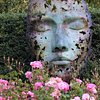
Top ways to experience nearby attractions

Most Recent: Reviews ordered by most recent publish date in descending order.
Detailed Reviews: Reviews ordered by recency and descriptiveness of user-identified themes such as wait time, length of visit, general tips, and location information.
Also popular with travelers
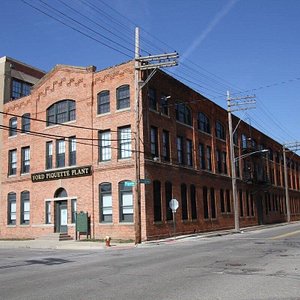
Fisher Building - All You Need to Know BEFORE You Go (2024)
- (0.10 mi) Hotel St. Regis
- (0.79 mi) The Inn on Ferry Street
- (2.68 mi) HOTEL DAVID WHITNEY, AUTOGRAPH COLLECTION
- (2.76 mi) ROOST Detroit
- (1.53 mi) El Moore Lodge & Residences
- (0.10 mi) Cuisine
- (0.07 mi) Stella Good Coffee
- (0.08 mi) Lunchtime Detroit
- (0.17 mi) Northern Lights Lounge
- (0.18 mi) Joe Louis Southern Kitchen
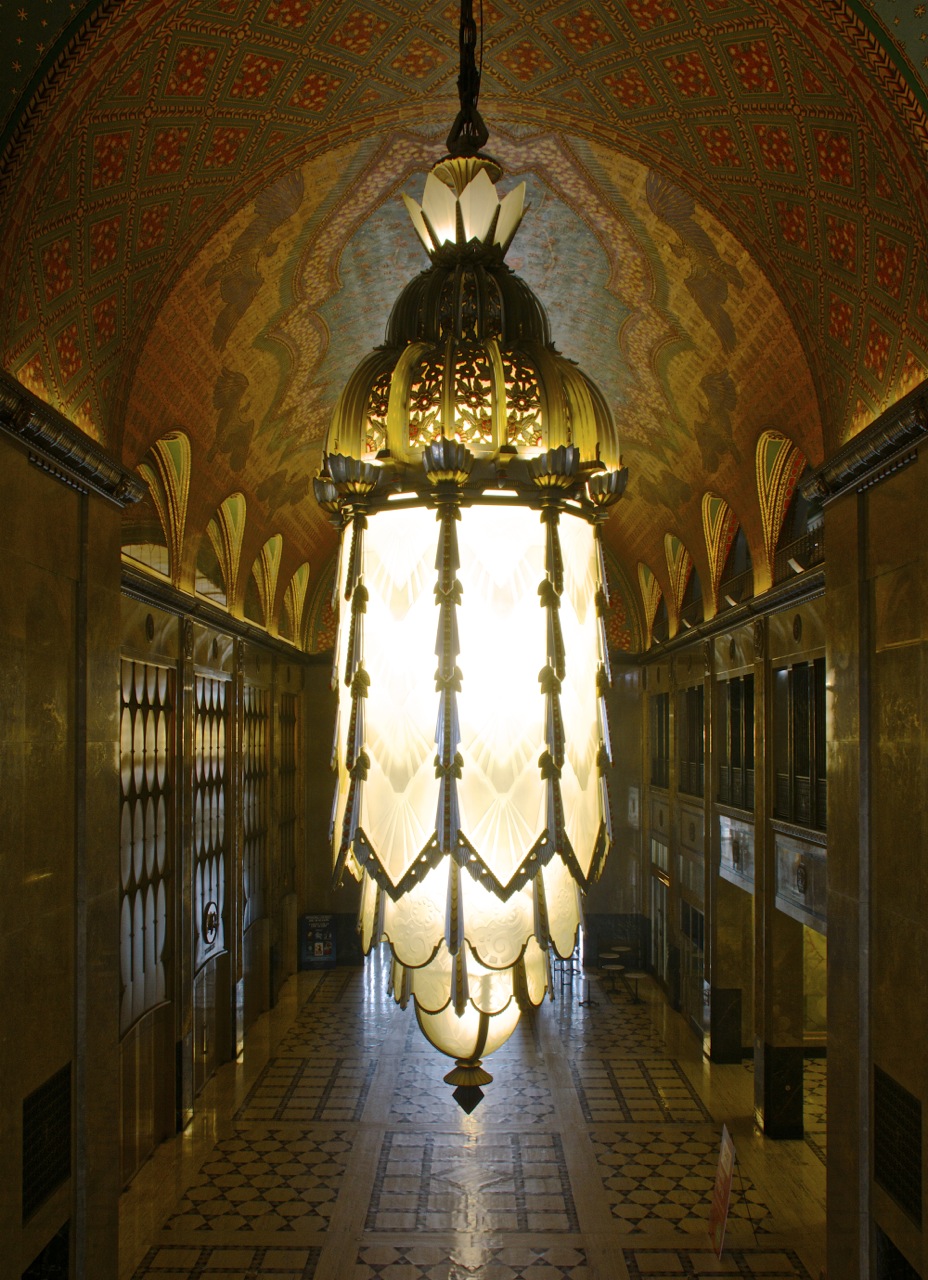
Historic Fisher Building Tours
- October 27, 2018
- Uncategorized
By: Bill Buccalo
Take a step back in time to get an up close and personal look at the gorgeous Fisher Building. Pure Detroit offers free guided tours to of the iconic building from knowledgeable guides who share the Fisher family history, details on the construction project, Albert Kahns’s 1928 Art Deco design, and what was “suppose to be” for the Fisher complex had the stock market not crashed just one short year later.
The late 1920’s were a time of great growth for Detroit, bringing many new downtown buildings like the Guardian, Stott, Fox Theatre, and Penobscot . The New Center area saw its own collection of skyscrapers; most notable was the Fisher Building.
I worked at the Fisher for several weeks per year back in the late 1980’s, and have attended plays at the Theatre over the years. However, the Pure Detroit tour provided the best look at the Fisher Building offering history, information, and access to areas otherwise off limits.
Tours are available on Saturdays and Sundays throughout the year. Check the Pure Detroit website for details. No reservations required. Feel free to bring your camera, and a tip for the guide is a nice gesture. Just show up before the scheduled tour time. Takes about an hour.
There are some good restaurant options in the area as well. See the List for recommendations.
Please like or follow Grazing Detroit on Facebook to see more posts like this.

You Might Also Like

Grazing Detroit gets new look for 2020
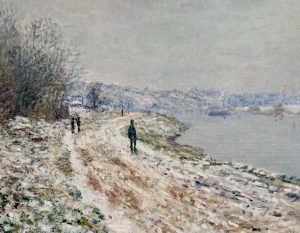
DIA Impressionists Exhibit ends this Sunday
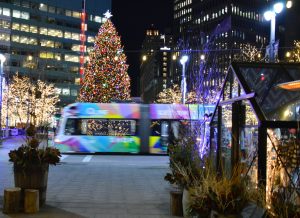
Grazing Detroit joins Instragram
Leave a reply cancel reply.

- The Detroit Historical Society
- Online Resources
- Our Museums
- Board of Trustees
- Annual Reports & Financials
- Detroit 67 Project
- Careers at the Society
- How To Contact Us
- Plan Your Visit
- Museum Events
- Exhibitions
- Detroit River Watch Webcam
- Lectures & Films
- Events By Month
- Partnership Programs
- Behind The Scenes Tours
- Historic Houses of Worship Tours
- Special Events
- All Society Events
- About The Collections
- Artifact Donation
- Finding Aids
- Research Resources And Loans
- Educator Portal
Encyclopedia Of Detroit
- Timeline of Detroit
- Speakers Bureau
- Book Tower Historic Exhibition
- 100 Years 100 Stories
- History X Design Tour
- About Membership
- Membership Levels
- Membership Plus
- Member Login
- Corporate Giving
- Planned Giving
- Sponsorship
- Cobblestone Circle
- Gifts in Honor and Memory
- Matching Gifts
- Volunteering
- Fisher Building
- Learning Resources
- Class Outreach
- Trips & Programs
- Untold Detroit: Beer | Episode 1
- Untold Detroit: Beer | Episode 2
- Untold Detroit: Beer | Episode 3
- Untold Detroit: Beer | Episode 4
- Untold Detroit: Beer | Episode 5
- Untold Detroit: Beer | Episode 6
- Behind the Scenes
- Centennial Celebration
- From the Collection
Often cited as “Detroit’s largest art object,” the Fisher Building has brightened the skyline of Detroit since 1928. The building was the project of the seven Fisher Brothers, of Fisher Body prestige. Originally carriage-makers, the brothers popularized the closed body for the automobile which made year-round car travel possible. When they decided to build offices for Fisher and Company, they were willing to spend whatever it took to make it the world’s most beautiful office building.
Built with careful attention to detail, the Art Deco Fisher Building features vaulted, hand painted arcade ceilings and an interior utilizing several varieties of marble, brass, and bronze. The brothers hired architect Albert Kahn who used the finest materials, craftsmen and contractors in building what would become Detroit’s tallest building outside of the Downtown Central Business District. When completed in 1928, Kahn was awarded the Architectural League’s silver medal which named the Fisher Building the most beautiful commercial building of that year.
Incredibly, construction took only 15 months at a cost of $3 million. The main tower’s roof was originally covered in gold leaf, but during World War II it was feared the shining gold leaf would be a target for bombers, so it was covered in asphalt. After the war, terra cotta green tiles were used to cover the asphalt and are illuminated at night to make them appear golden.
Kahn hired Geza Maroti, an artist from Budapest, Hungary who worked at Cranbrook , for the inside sculptures, mosaics and frescoes for the building. His works in the Fisher Building contain extensive symbolism focusing on two ideas: the wealth and power of the United States conveyed through commerce and transportation, and American culture and civilization imparted through music and drama. The building also contains architectural sculpture by the prolific Corrado Parducci. Originally, the building was to include three skyscrapers, but the onset of the Great Depression limited the project to one tower. The completed building measures more than 440 feet high, with a barrel vaulted lobby that features more than 40 different kinds of marble and an exterior covered in more than 325,000 square feet of marble. There are also tunnels connecting the Fisher Building to what was the General Motors Building across Grand Boulevard and to the New Center Building. The Fisher Building is home to offices for organizations and professionals, dentists and doctors, banks, retail shops, the renowned Fisher Theater, and the studios of WJR-AM 760 . The Fisher Building was added to the National Register of Historic Places in 1989.
RELATED ITEMS IN THE COLLECTION

View all items related to the Fisher Building
- About This Site

© 2024 Detroit Historical Society. All Rights Reserved. | 5401 Woodward, Detroit, MI 48202
- Centennial History
- Centennial Programs & Events
- Signature Centennial Exhibitions
- Detroit Historical Museum
- Dossin Great Lakes Museum
- Remembering Marlowe Stoudamire
- A Tribute to Joseph L. Hudson, Jr.
- Production Guidelines
- DHS Image Library
- Contact P.R.
- From the President & CEO
- Accessibility
- School Tours & Programs
- Admissions F.A.Q.s
- Group Tours & Programs
- Events Listing
- Signature Exhibitions
- Changing Exhibitions
- Traveling Exhibitions
- General Information & Pricing
- Approved Caterers & Vendors
- Event Images
- Sample Floor Plans
- Submit an Event Inquiry
- Advisors & Sponsors
- General Information
- Outdoor Enhancement Project
- Virtual Exhibitions
- Themed Lessons
- High School Research Project
- Annual Support
- General Donation
- Honorary Gift
- Memorial Gift
- Volunteer Information
- Docent Information
- Internship Information
- Volunteer Resource Center
- Remembering Mac McAdam
" style=" object-fit:cover;object-position:50.0% 50.0%; " > " > Pure Detroit
Detroit's fabulous fisher building - the birth of detroit’s largest art object.
By Jacob Jones In the Roaring Twenties, the only thing that Detroit was producing at a faster rate than cars was money. The automotive industry had turned Detroit into one of the largest and wealthiest cities in the world. The economic boom led to a massive building operation in the city. Each new factory was larger than the last, homes were built surrounding the automotive campuses, and skyscrapers rose high above the city’s car filled streets. Detroit had arrived as an industrial metropolis. Today, the city’s 1920’s skyscrapers, homes, and factories serve as a sort of time capsule to a moment when Detroit was on the forefront of the industrial world. But perhaps no building in the city better captures the richness of the era better than the Fisher Building. Built by a family of auto body builders, the Fisher combines industrial might and classical beauty to create a structure that is just as much an art object as a skyscraper.

The Fisher Brothers made their wealth in the early days of the automobile industry. The brothers emerged from a family of show-carriage builders. At the turn into the 20th century, the oldest brothers began to apply their carriage expertise to the new horseless carriage industry. The Fishers would revolutionize the automobile industry from the offices of their carriage company. The Fisher Body Company’s grandest achievement was the development of enclosed auto bodies, which broke the status quo in the early automobile scene, turning it from an open air vehicle to the enclosed, reliable form of transportation that it is today.

The Fisher’s eventually caught the eye of General Motors and through a series of transactions, GM would bring Fisher Body in house. The sale brought in hundreds of millions of dollars for the Fishers and with this massive amount of income, the brothers directed their focus towards something new; the building of the world’s most beautiful skyscraper. Under the direction of Albert Kahn and Associates, the Fisher Brothers got to work. Breaking ground on August 22nd of 1927, in front of crowd that included the Governor of Michigan and the Mayor of Detroit, the Fisher Building rose through the city’s sky at an alarmingly rapid rate. The Building would be opened on September 1st, 1928 and would immediately gain recognition. The 441 ft. tower led to Albert Kahn being awarded the Silver Medal by the Architectural League of New York and the building was named the most beautiful commercial structure in the world. The Fisher Brothers had achieved their ultimate goal.

Walking through the lobby, one can glance at the fresco ceilings, marble walls, bronze doors, and art deco chandeliers and understand why the Fisher Building is known as Detroit’s Largest Art Object. While the beauty of the Fisher Building may speak for itself, there are countless stories behind the building’s history that one must hear to believe. Luckily, Pure Detroit offers exclusive tours of the building. An expert guide will lead you from Pure Detroit’s flagship location in the building’s grand arcade through the building. You will learn the most intimate details behind the family, artists, and architects involved in its creation. The hour long tour will also provide you access to the building which is unavailable to the general public. To reserve your spot on one of Pure Detroit’s public or private tours please head to: https://www.eventbrite.com/o/pure-detroit-3623406533
Also, check out these premium Pure Detroit T's that celebrate Detroit's Fisher Building:

- Interactive Map Regions
- Upper Peninsula
- Northern Michigan
- Mid Michigan
- Southwest Michigan
- Southeast Michigan
- Battle Creek
- Copper Harbor
- Drummond Island
- Frankenmuth
- Grand Haven
- Grand Rapids
- Harbor Springs
- Houghton Lake
- Isle Royale
- Leelanau Peninsula
- Mackinac Island
- Mackinaw City
- Mt. Pleasant
- Sault Ste Marie
- Silver Lake
- South Haven
- Traverse City
- Michigan Events By Month
- Michigan Renaissance Festival
- Grand Rapids Lantern Festival
- Herbalist Festivals/Events
- Michigan Music Festivals
- Frankenmuth Flower Festival
- Blakes Lavender Festival
- Michigan Mushroom Festivals
- Plymouth Ice Festival
- Michigan Blueberry Festivals
- Polar Express Train
- Christmas Lights
- Rochester Christmas
- Meadow Brook Hall Christmas
- Kris Kringle Market Rochester
- Downtown Detroit Christmas
- Dow Gardens Christmas Walk
- Canterbury Village
- Live Nativity
- Christmas Events
- Midland Santa House
- Christmas Trains
- Silver Bells In The City
- Huckleberry Train
- Detroit Tree Lighting
- Christmas Towns
- Christmas Markets
- Rochester Christmas Lights
- Greenfield Village Holiday Nights
- Frankenmuth Christmas
- Indoor Water Parks
- Reindeer Farms
- Snow Tubing
- New Years Eve
- Nordic Fire Festival
- Frankenmuth Snowfest
- Tip Up Town Festival
- Michigan Holiday Events
- Michigan Tech Winter Carnival
- Valentines Events
- Michigan Valentines
- Pure Michigan Events
- St. Patrick's Day
- Easter Events
- Maple Syrup Festival
- 2024 Tulip Festival
- Festival Planner
- Interactive Maps
- Best Restaurants
- Holland Breweries
- Top 10 Things To Do
- Mackinac Island Lilac Festival
- Michigan Lavender Festival
- Great Lakes Bay Invitational
- KitchenAid Senior PGA Championship
- Grand Prix Detroit
- Cherry Festival
- Michigan Fireworks Displays
- 4th of July Events
- St Joseph Fireworks
- Bay City Fireworks
- Detroit Fireworks
- South Haven Fireworks
- Frankenmuth Events
- Ann Arbor Art Festival
- Michigan Air Shows
- Hot Air Balloon Festivals
- Coast Guard Festival
- Woodward Dream Cruise
- Detroit Autorama
- Metro Cruise Grand Rapids 28th Street
- Apple Festivals
- Michigan Fairs
- Corn Maze Farms
- Detroit International Auto Show
- Oktoberfest
- Labor Day Weekend
- Halloween Events
- Detroit Haunted Houses
- Grand Rapids Haunted Houses
- Fall Train Rides Color Tours
- Haunted Houses
- Elk Viewing
- Fall Festivals
- Turkey Farms
- Mackinac Bridge Walk
- Thanksgiving Day Parade
- Michigan Harvest Calendar
- U Pick Farms
- Asparagus Farms
- Apple Farms
- Blueberry Farms
- Cherry Farms
- Honey Farms
- Cider Farms
- Uncle Johns Cider Mill
- Lavender Farms
- Flower Farms
- Peach Farms
- Pumpkin Farms
- Raspberry Farms
- Strawberry Farms
- Sunflower Farms
- Zoos & Aquariums
- Binder Park Zoo
- Detroit Zoo
- Michigan Petting Zoos
- Wilderness Trails Zoo
- Sea Life Aquarium
- Shipwreck Museum
- Detroit Art Museum
- Henry Ford Museum
- Mackinaw Maritime Museum
- Huron Lightship Museum
- Greenfield Village
- Motown Museum
- Michigan Farming-Agriculture
- Flint Institute of Arts
- Lumbermans Monument
- Meadow Brook Hall
- Fort Gratiot Lighthouse
- Japanese Tea Ceremony
- Michigan Capital
- Heidelberg Project
- 6 Top Getaways
- Lake Huron Day Trip
- Private Jet Flying
- Best Scenic Road Trip Grand Rapids To UP
- 7 Top-Rated Michigan Vacation Ideas
- Michigan Map
- Best Places to Stay on The Beach
- Luxury Home Rentals
- Vacation Rentals in Michigan
- Sleeping Bear Dunes Road Trip
- Traverse City Hotels
- Midland Hotels
- Mackinaw Island Hotels
- Frankenmuth Hotels
- Inn At Bay Harbor
- Things to do in Winter
- UP Road Trip
- UP Waterfalls Road Trip
- Michigan U Pick Farms
- Michigan Travel Guide Map
- Drive In Theaters
- Dow Gardens
- Ford Model "T" Plant Tour
- Ford F150 Factory Tour
- Tour the Capital
- Fisher Building Tour
- Interesting Places in Michigan
- USS Edson Ship Tour
- Castle Farms Tour
- Alden B Dow Home Tour
- Guardian Building Tour
- Dark Sky Parks
- Kitch Iti Kipi
- Northern Lights
- Mushroom Houses Charlevoix
- Midland Canopy Walk
- Best Michigan Small Towns
- Worlds Largest Cherry Pie
- Pierce Stocking Scenic Drive
- Michigan Tunnel of Trees
- Epic Michigan Fall Tour
- Fall Activities
- Fall Colors in Michigan
- Haunted Places In Michigan
- St Ignace Car Show
- Frankenmuth Car Show
- Fall Color Map
- Eben Ice Caves
- Tahquamenon Falls in Winter
- Winter Festivals
- Kitchiti Kipi in Winter
- World of Winter
- Ski Resorts
- Tubing in Michigan
- 8 Winter Getaways
- Frankenmuth in Winter
- Winter Interesting Places
- Michigan Ice Skating Rinks
- Ice Skating Detroit
- Mackinaw City In Winter
- Frozen Waterfalls
- Michigan Sleigh Rides
- Hot Air Balloon Rides
- Battle Creek Field Of Flight
- Hiking Trails
- Find Yooperlite Rocks
- Tahquamenon Falls State Park
- Shiawassee Wildlife Refuge
- Kensington Metropark
- Arcadia Dunes
- Oval Beach Saugatuck
- Boardman Lake Trail Hike
- Largo Springs
- Thorne Swift Nature Preserve
- Pictured Rocks
- Kalamazoo Hiking Trails
- Tannery & Memorial Falls
- Seney National Wildlife Refuge
- Fossil Hunting
- Munising Falls
- Wagner Falls
- Sleeping Bear Dunes
- Silver Lake Dunes
- Michigan Botanical Gardens
- Ludington State Park
- Saugatuck Dunes State Park
- Michigan National Parks
- Southwest Michigan Golf Courses
- Great Lakes Loons Baseball
- Detroit Auto Show
- South Haven Lighthouse
- Point Betsie Lighthouse
- Michigan Diners, Drive In's and Drives
- Best Michigan Pizza
- Michigan Drive Ins
- 5 Insane Michigan Restaurants
- Best Michigan Burger
- 9 Insane Restaurants in Michigan
- Midland Michigan Restaurants
- Kalamazoo Restaurants
- Best Alpena Restaurants
- Midland Coffee Shops
- Farm to Table Restaurants
- Detroit Diners Drive Ins and Dives
- Michigan Cat Cafes
- Best Frankenmuth Restaurants
- Superman Ice Cream
- Michigan Pasty
- French Bread
- French Toast
- Green Smoothie
- Strawberry Pie
- Strawberry Shortcake
- How to Freeze Blueberries
- How To Freeze Strawberries
- Valentines Restaurants
- Michigan Thanksgiving Dinner
- Michigan Christmas Dinner
- Culinary Schools
- Michigan Breweries
- Best Grand Rapids Michigan Breweries
- Michigan Winery's
- Michigan Wines
- Outlet Malls
- Michigan Hats
- Michigan Experience Gifts
- e-Bikes & Michigan Rules
- Michigan Gifts
- Michigan Themed Gifts
- Michigan Gift Baskets
- Made in Michigan
- Adventure Gifts For Guys
- Valentine Gifts
- Best Pants for Cold Weather
- Michigan Necklaces
- Best Camelbak
- Bronners Frankenmuth
- Best Raincoats for Women and Men
- Holland Shopping
- Travel-MI Blog
- Things To Do Michigan
- 7 Day Michigan Itinerary
- Carriage House at the Harbor
- Northern Michigan Kayaking
- Things to Do Frankenmuth
- Things To Do Saugatuck
- 17 Interesting Places
- Best Golf Courses Michigan
- Things To Do Traverse City
- Things to See in Detroit
- Things To Do Belle Isle
- Things To Do Mackinac Island
- Things to Do Detroit
- 7 Holland Incredible Places
- Insane Michigan Places
- Adventure Travel
- Motorsports
- Snowmobiling Marquette
- Michigan Snowmobiling
- Paintball Parks
- Edmund Fitzgerald Wreck
- Travel-MI Authors
- Author: Sherry Trautman Bio
- Author: Chris Trautman Bio
Accessibility
- Contact us! Let's keep in touch!
Fisher Building: Tour This Astonishing Mosaic and Chandelier Laden Skyscraper Offering Epic 360 Degree Views of Detroit

By Sherry Trautman
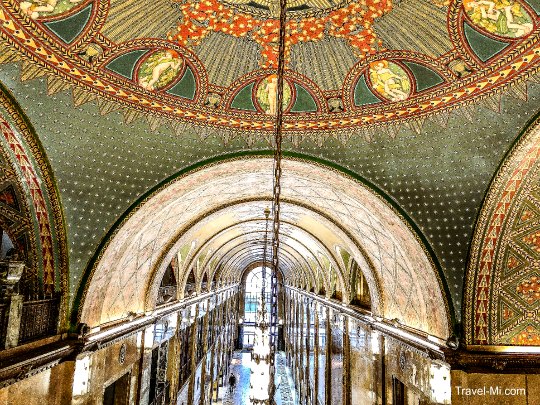
Fisher Building | By Sherry Trautman | Traveling Michigan
Detroit Michigan is home to stunning museums, architectural marvels, cutting edge restaurants, casinos and theaters. The Fisher Building is a fine example of an architectural marvel.
See our main Detroit page for our full listing of fantastic things to see in Detroit all year round.
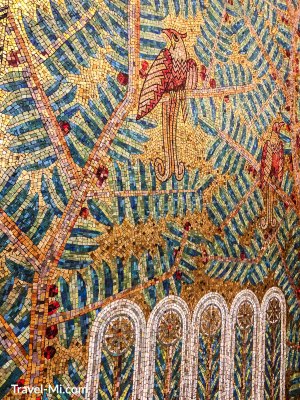
Tour the Incredible Fisher Building
This landmark skyscraper is located at 3011 West Grand Boulevard.
So this is cool: Pure Detroit, located on the corner of Lothrop and Second on the first floor, offers FREE Tours (approximately 1 hour) of this magnificent Art Deco building erected in 1928.
You will be wowed by stunning mosaic floors, breathtaking ceilings and even the elevator doors are bronze works of art. They don't make 'em like this anymore!
- Awesome photo opportunities!
- Great views! Oh, and there's a coffee shop...just sayin'
Great shopping is also on the first level. Be sure to check out the Detroit Gallery of Contemporary Crafts for great wearable art.
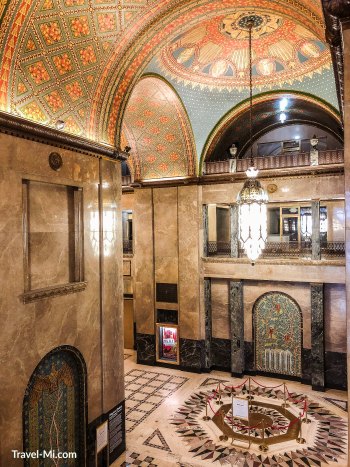
What is the Purpose of the Fisher Building?
The Fisher Building was designed to house office and retail space. The building also contains the stunning 2,089-seat Fisher Theatre. The theatre presents spectacular Broadway productions! Check one out and you won't be disappointed!
It also houses the headquarters for the Detroit Public Schools and the studios of radio station WJR.
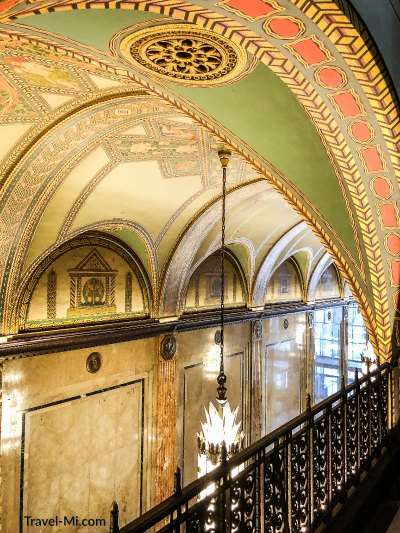
Fisher Building General Information
The Fisher building is open to the public.
Tours: Pure Detroit offers guided tours of this magnificent building. It's an incredible way to discover the history of the building and see 360° views of Detroit.
Parking: We found the easiest spot to park was in a surface lot directly across from the entrance to the Pure Detroit entrance.
Handicap Accessible : Tours through Pure Detroit are wheelchair accessible as one person in our party was in a wheelchair. I was able to maneuver the wheelchair into the elevators and throughout all the floors without problems.

Once You Come Inside...
A plaque near the famous elevator reads, "The Fisher Building, known as "Detroit's Largest Art Object," was originally conceived by the Fisher Brothers as an Ode to the American builder and Craftsman. The Fishers spared no expense in its construction ($9 million dollars!), which is evidenced in the spectacular frescoes, mosaics, marble, and brass work adorning interior surfaces."
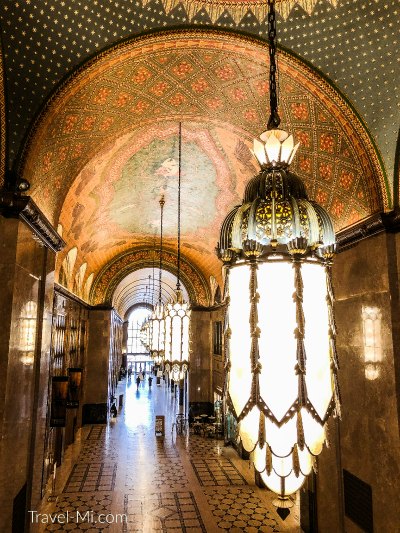
The main arcade of the Fisher Building is 30 feet wide, 44 feet high and 600 feet long. You can't help but immediately notice the spectacular art deco chandeliers; ranging from 5 to 8 feet tall.
Several colorful and detailed mosaics adorn the walls and intricate bronze medallions cover the floors. 40 different varieties of marble were sourced from all over the world. You will see lots of brass and bronze throughout the vast interior.
“We travel, some of us forever, to seek other places, other lives, other souls.” – Anais Nin
If you are needing a treat or a coffee to perk you up before your tour, there is a great office shop down the main hall on the left.
Restrooms are also located throughout the building.
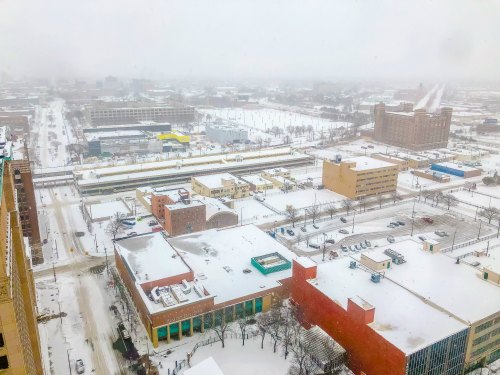
Did You Know the Fisher Building is a National Historic Landmark?
The building was designated a National Historic Landmark on June 29, 1989.

The Fisher brothers spent $9 million dollars to create The Fisher Building
Pin the Fisher Building Page
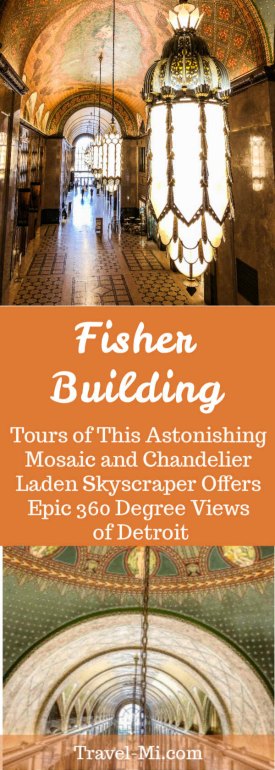
Popular Articles About Detroit!
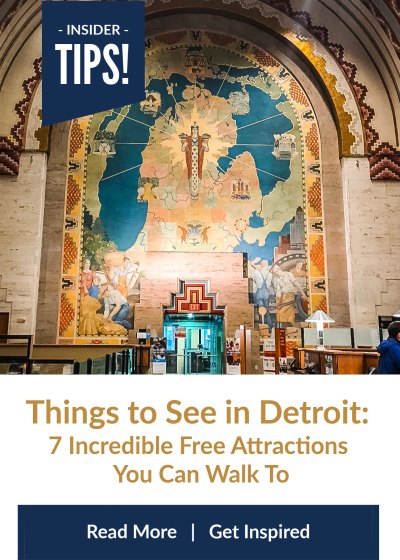
Subscribe To Receive Exciting Destinations, Day Trips and Fun Directly to Your Inbox!

Sign Up to Our Newsletter to Get the 5 Free Must Have Apps to Travel in Michigan Like a Boss!
Follow us on instagram .
TravelingMichigan
View this post on Instagram When we were wandering around Belle Isle, I discovered this very cool round abandoned structure. I was reading that it used to be a zoo on Belle Isle in Detroit! You can still see the gates to get into the zoo, some cages and exhibits but it now stands abandoned. ⠀⠀⠀⠀⠀⠀⠀⠀⠀ .⠀⠀⠀⠀⠀⠀⠀⠀⠀ In 1947, the Belle Isle Zoo was downsized to a children’s zoo and finally closed in 2002. Bummer, huh!⠀⠀⠀⠀⠀⠀⠀⠀⠀ .⠀⠀⠀⠀⠀⠀⠀⠀⠀ .⠀⠀⠀⠀⠀⠀⠀⠀⠀ .⠀⠀⠀⠀⠀⠀⠀⠀⠀ #deservetopreserve #abandoned #abandonedzoo #belleisle #belleislepark #detroit #abandoneddetroit #photooftheday #michigan #michigander #michiganphotographer #detroitmi #detroitmichigan #motorcity #detroitcity #detroitdecay #detroit_igers #detroitlove #forgottenplaces #beautyindecay #urbanexploration #urbanexplorers #explore #michiganaddict #detroitgraphiti #urbanexplore #abandonedplaces #beautyindecay #deserve2preserve A post shared by Michigan Travel+Food Adventure (@travelingmichigan) on Sep 16, 2019 at 5:15am PDT
- Traveling Michigan Home Page
- Fisher-Building

About the Lead Author | Sherry Trautman
Thanks for stopping by.
Our Words of Wisdom: “Never follow anyone else’s path. Unless you’re in the woods and you’re lost and you see a path, then by all means follow that path.”
"Sherry & Chris"
We're Sherry and Chris the founders of one of Michigan's most comprehensive and Top Travel Blogs!
Sherry Trautman is a seasoned business owner and a multifaceted content creator, deeply entrenched in the world of travel in Michigan. With her extensive background in writing, editing, photography, marketing, website design, web mastering, social media, and publishing, she is the driving force behind the acclaimed Michigan Travel site "Travel-mi.com." A lifelong Michigander, Sherry's journey began in Mt. Pleasant, Michigan led her to St. Joseph during her formative years, and further to Kalamazoo for her higher education. She holds a Bachelor of Science in Industrial Design and Fine Art from Western Michigan University. Her career initially blossomed in Battle Creek, where she contributed significantly to aviation, marketing, and the art industry. In 2018, Sherry, alongside her husband Chris, embarked on a passionate endeavor with the inception of Travel-MI.com. This venture was not just a business but a full-time commitment to exploring and celebrating the diverse landscapes and communities of Michigan. Together, they tirelessly traverse the state, curating unique experiences, capturing stunning visuals, and weaving engaging narratives that showcase Michigan's rich cultural tapestry and natural beauty. From her early experiences in different Michigander locales to her extensive professional background, Sherry's life and work epitomize a deep-rooted expertise in Michigan travel, making her an authoritative voice in this niche.

JOIN OUR NETWORK Join our newsletter of Michigan Explorers!
Share social.
When you wish destinations came with a 30 second trailer so you can see what you’re getting yourself into.
If you whine and are nice, IM us and we will tell you if you are truly screwed or not.
Where Do You Want To Start Your Next Adventure?

Disclosure Policy
Privacy Policy
Disclaimer Statement

"We improve our products and advertising by using Microsoft Clarity to see how you use our website. By using our site, you agree that we and Microsoft can collect and use this data. Our privacy policy statement has more details."
Sponsorship
Our Gallery
Travel- MI. com
2014 N Saginaw Rd
Midland, MI 48640
© Copyright Travel-mi.com 2018-2024
- Visit Family Vacation Critic on Facebook!
- Visit Family Vacation Critic on Twitter!
- Visit Family Vacation Critic on Instagram!
- 1 Subscribe to stay up to date!
- Destinations
- Michigan Attractions
Fisher Building Tour
3011 W Grand Blvd., Detroit, MI
- Little Kids 3-6
- Big Kids 7-9
- Tweens 10-12
- Teens 13-17
Just as they do inside the Guardian downtown, Pure Detroit offers free 45-minute to 1 hour tours of the Fisher that will get you and your kids up close to the fresco paintings on the ceilings, provide you views of the city from on high and teach about the grander architectural plan that was meant to grace Detroit’s midtown. Bring your camera for some amazing artistic opportunities!
Hours Tour times vary seasonally, but free, guided tours of both buildings are usually offered multiple times each weekend day.
Your personal family vacation planning starts now
Get expert advice, handpicked recommendations, and tips for your family all year round!
Get family travel & tips from our experts
By proceeding, you agree to our Privacy Policy and Terms of Use .
Thanks for signing up!
How To Take The Ultimate Vacation In Detroit
Senior Reporter, HuffPost Life
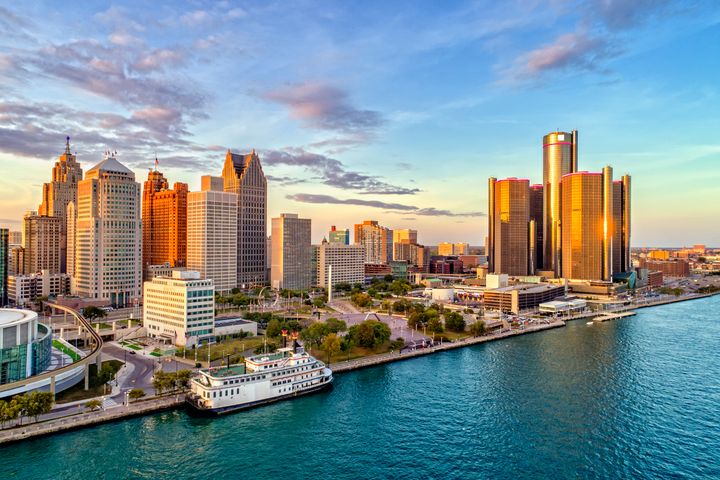
Take a Break is your ultimate guide to the perfect trips to recharge, rediscover yourself and your relationships, and reengage with the world. We’ll cover shopping stops, great bars, restaurants worth your money, photo opportunities, memorable experiences and other important details you need before you book.
Thousands of football fans and sports professionals descended on downtown Detroit over the weekend as the city hosted the 2024 NFL Draft. It’s a fitting location: the home of iconic sports franchises, including the Lions, Pistons, Tigers and Red Wings. But Detroit has so much more to offer beyond the world of sports.
I recently had the opportunity to spend a long weekend in the Motor City with some friends and was impressed by the diverse cuisine, cool shops and welcoming locals. Although the airport services more than 125 destinations (including 30 international), I’ve found that Detroit is not particularly high on travelers’ lists of American cities to visit.
I personally think that should change, and I had the chance to talk to many locals who agree. If you need more convincing, I put together some favorite sites, bites and more.
Where To Stay
I stayed at The Siren Hotel in downtown Detroit and loved the vintage decor and buzzy atmosphere.
It’s a boutique hotel with about 100 rooms and two great bars — including one where you can watch the Detroit People Mover go by as you enjoy a nice cocktail. The other is a pink oasis off the lobby, complete with plush velvet seating and a stunning chandelier.
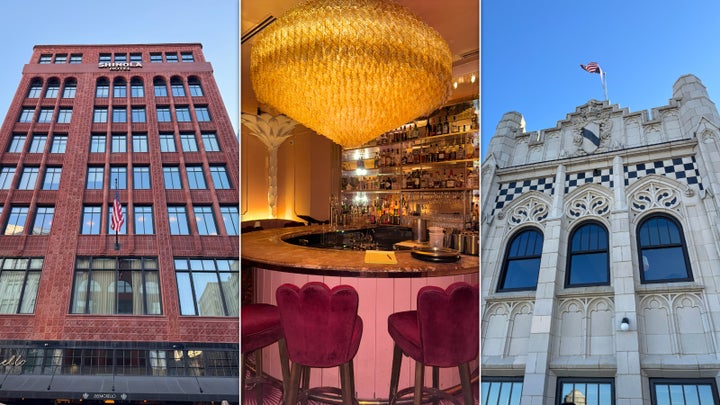
Another popular boutique offering is the Shinola Hotel , which is affiliated with the Detroit-based lifestyle brand of the same name. Naturally, the lobby spaces and rooms are outfitted with Shinola products, from clocks and record players to blankets and candles.
What To Eat
Practically everything I ate in Detroit was fantastic, but my favorite meal was at Baobab Fare , a colorful East African restaurant opened by Burundian refugees. Baobab Fare, a 2024 James Beard Award finalist, serves up delicious beef stew, fried fish, slow-roasted goat shank and more.
I also had a wonderful meal at a Lebanese spot called Leila and a top-notch sandwich and latte at the multipurpose cafe Trinosophes . I’ve heard great things about Yemen Cafe , Yumvillage and SavannahBlue as well.

Sampling some Detroit-style pizza was a must, and my travel companions and I got our fix at Como’s in Ferndale. We also picked up some incredible hummus and other dips from AlTayeb in Dearborn.
On the sweet side, I was a big fan of the pastries at Warda Pâtisserie and bite-sized chocolate treats at BonBonBon (shoutout to the local “Bumpy Cake” flavor).
Detroit is also known for its “Coney dogs,” served at eateries known as Coney Islands. And although locals told me it’s a tourist trap, I’m still curious to check out Eminem’s restaurant, Mom’s Spaghetti , on a future visit.
What To Drink
In addition to enjoying cocktails at The Siren, my group had some excellent rooftop drinks at The Monarch Club at the top of the historic Metropolitan Building.
We also visited Ghost Bar, in the historic mansion-turned-restaurant The Whitney (named for its former resident, lumber baron David Whitney). According to lore, the building is one of the most haunted spots in Detroit and offers guided tours.

Other bars we enjoyed were Cafe Sous Terre (which is a coffee shop during the day), Bumbo’s and Temple Bar . We had a wonderful time dancing at Spot Lite . A friend also recommended the perfume-themed cocktails at Castalia at Sfumato and Salty Dog, a quirky dive bar shaped like a boat.
As for non-alcoholic drinks, we had some great coffee at The Red Hook and Madcap Coffee .
There are plenty of activities and experiences to fill a Detroit weekend itinerary. My friends and I spent time strolling the Riverwalk and exploring Belle Isle, which has lovely natural vistas and a small free aquarium that dates back to 1904 and is covered in stunning green tile. Later, we visited the historic Fisher Building and admired the impressive mosaic interiors.
I carved out a little solo time to check out the Motown Museum , located in the original “Hitsville U.S.A.” headquarters and recording studio. The guided tour was a special experience in no small part due to my fellow tour-goers, who enthusiastically took in every detail and sang along to the Motown hits that played along the way. A couple of music-lovers even started to tear up at points because they felt so overwhelmed with emotion to be in the place where such important artists recorded iconic songs that endure to this day.
When I met back with my group, we shopped around Eastern Market and saw some of the murals in the area. We also went over to Cass Corridor and hit Third Man Records , Shinola and City Bird . As Carhartt is headquartered in the Detroit area, we made sure to pop in at one of the brand stores as well.
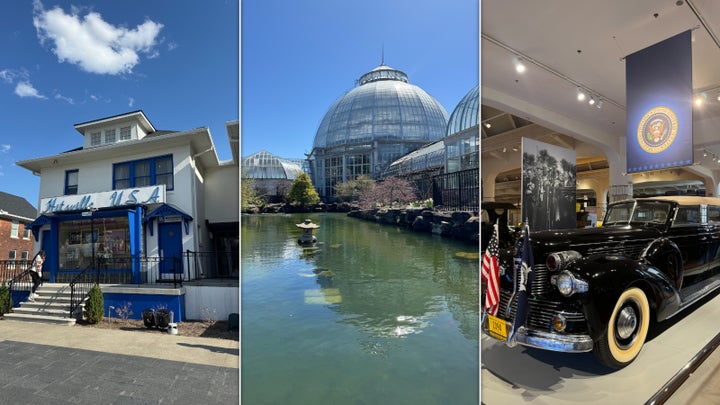
Being in the Motor City, I felt compelled to visit the Henry Ford Museum of American Innovation . It’s an impressive complex with endless artifacts and information about the history of transportation in the U.S., and it includes Greenfield Village, an outdoor living history museum where visitors can ride around in authentic Model Ts, old steam trains and horse-drawn carriages.
I can see why the museum is a popular stop for tourists, especially families traveling with children, but I was curious to see how the museum grapples with its namesake’s antisemitic history . Unfortunately, I did not see any acknowledgment at the museum of this dark reality, though I later found a section on its website (and perhaps I simply did not come across a similar exhibit on the property).
Although I wasn’t able to explore The Detroit Institute of Arts , I’ve heard great things about its collection, and on a future visit, I’d be interested to check out The Heidelberg Project as well.
Our 2024 Coverage Needs You
It's another trump-biden showdown — and we need your help, the future of democracy is at stake, your loyalty means the world to us.
As Americans head to the polls in 2024, the very future of our country is at stake. At HuffPost, we believe that a free press is critical to creating well-informed voters. That's why our journalism is free for everyone, even though other newsrooms retreat behind expensive paywalls.
Our journalists will continue to cover the twists and turns during this historic presidential election. With your help, we'll bring you hard-hitting investigations, well-researched analysis and timely takes you can't find elsewhere. Reporting in this current political climate is a responsibility we do not take lightly, and we thank you for your support.
Contribute as little as $2 to keep our news free for all.
Can't afford to donate? Support HuffPost by creating a free account and log in while you read.
The 2024 election is heating up, and women's rights, health care, voting rights, and the very future of democracy are all at stake. Donald Trump will face Joe Biden in the most consequential vote of our time. And HuffPost will be there, covering every twist and turn. America's future hangs in the balance. Would you consider contributing to support our journalism and keep it free for all during this critical season?
HuffPost believes news should be accessible to everyone, regardless of their ability to pay for it. We rely on readers like you to help fund our work. Any contribution you can make — even as little as $2 — goes directly toward supporting the impactful journalism that we will continue to produce this year. Thank you for being part of our story.
It's official: Donald Trump will face Joe Biden this fall in the presidential election. As we face the most consequential presidential election of our time, HuffPost is committed to bringing you up-to-date, accurate news about the 2024 race. While other outlets have retreated behind paywalls, you can trust our news will stay free.
But we can't do it without your help. Reader funding is one of the key ways we support our newsroom. Would you consider making a donation to help fund our news during this critical time? Your contributions are vital to supporting a free press.
Contribute as little as $2 to keep our journalism free and accessible to all.
Dear HuffPost Reader
Thank you for your past contribution to HuffPost. We are sincerely grateful for readers like you who help us ensure that we can keep our journalism free for everyone.
The stakes are high this year, and our 2024 coverage could use continued support. Would you consider becoming a regular HuffPost contributor?
The stakes are high this year, and our 2024 coverage could use continued support. If circumstances have changed since you last contributed, we hope you'll consider contributing to HuffPost once more.
Already contributed? Log in to hide these messages.
Popular in the Community
From our partner, huffpost shopping’s best finds, more in life.
Detroit’s Fisher Building to host pop-up holiday market, free tours, performances

Holiday shopping and entertainment will come to the Fisher Building this weekend.
The afternoon event will feature more than 20 vendors, performances and tours, marking Detroit's holiday season.
"The holidays are a great time to experience the historic Fisher Building," said Clarke Lewis, president of the Platform, the real estate development company that owns the building.
The marketplace shopping will include over 20 pop-ups and permanent retailers, with merchandise including clothing, health and beauty, home goods, holiday decor, accessories and baked goods.
TechTown will partner with the Fisher Building for the event, featuring pop-up vendors from its Retail Boot Camp graduates. The 12-week program prepares future entrepreneurs to run businesses in Detroit, Hamtramck and Highland Park.
"TechTown is thrilled to collaborate on this festive pop-up marketplace in the iconic Fisher Building, providing an exciting opportunity for our program alumni to thrive," said Christina Devlin, TechTown Detroit Retail Strategist.
‘Twelve Days of Christmas’: Buying gift list would cost you $46,729 in 2023
The Fisher Theatre will host performances of the "Rudolph the Red-Nosed Reindeer" musical at 7 p.m. Friday and 11 a.m. and 3 p.m. Saturday. Tickets are available for purchase online or at the Fisher Theatre box office.
Pure Michigan will host tours of the building — a national historic landmark — during the event. Guests can reserve tickets online for the free tours, to be held at noon, 2 p.m. and 6 p.m. Saturday.
"There is a reason it’s one of the city’s top tourist attractions and known as Detroit’s largest art object," Lewis said. "By combining the holiday market, theatre performances and tours, the Fisher offers something for everyone and a memorable holiday experience."
The holiday market will run from noon to 5 p.m. at the Fisher building Saturday.

5 things to do in Detroit for less than $5
I nflation’s still too high even if it’s not as bad as it was a few months ago, and cash is tight, but lucky for you, Detroit’s a city where a little bit of money can add up to a full day of activities.
There’s plenty to do in the Motor City without breaking the bank.
Here are five things to do in Detroit for $5 or less:
Start the day smarter. Get all the news you need in your inbox each morning.
Check out some historic buildings
People often think of cars and music when they mention Detroit, but the city’s got some notable and beautiful buildings as well. We’ll highlight just three, all dating to the 1920s that are free to visit, starting with the Guardian Building, 500 Griswold .
The building is owned by Wayne County and currently houses many key county offices, including for the executive and county commissioners. The main lobby (accessible to the public) of the 40-story building, is “reminiscent of a cathedral, with colored marble, stained glass windows, massive pillars, intricate metalwork, and a barrel-vaulted ceiling decorated with decorative colored Pewabic and Rookwood tiles meant to convey strength and stability,” according to the Detroit Historical Society.
But the Guardian's not the only Art Deco stunner. New Center boasts “ Detroit’s largest art object,” the Fisher Building , 3011 W. Grand Blvd. Descriptions of this Albert Kahn-designed masterpiece won’t do it justice. You have to see the inside of the 441-foot tower “with its three-story arcade adorned with spectacular frescoes, mosaics, marble and brass,” as noted on its website.
Pure Detroit also gives free tours. You can also shop and take in a show at the Fisher Theatre, although those’ll cost you.
Returning back along Woodward Avenue, the Detroit Public Library’s Main branch building, 5201 Woodward , offers another visual feast for architecture buffs. Access is currently limited to the first floor while the public elevator is being replaced (likely to take several months, a staffer told the Free Press in mid-July, so you might want to visit again when the upper floors are accessible). The Italian Renaissance style library was once called the most beautiful building in Detroit, according to the library website.
Visit the Detroit Institute of Arts
If you live in Macomb, Oakland or Wayne counties, you have free access to the art museum, 5200 Woodward, because of a property tax millage that provides funding. The museum, one of the top art museums in the country, is across Woodward from the Main library building, so you could make it part of your historic building tour, too, before or after checking out the library. But the DIA, with its estimated 65,000 works, is really a stop unto itself .
You can easily spend a day or more at the museum, checking out the collections, covering Indian and South Asian, Japanese, Islamic, American as well as specifically African American, Ancient Greek and Roman and European offerings among others.
The Rivera Court, featuring Diego Rivera’s “Detroit Industry Murals,” is a must-stop location on out-of-town visitor itineraries, and metro Detroiters shouldn’t hesitate to reacquaint themselves with this special place.
Hang out at Campus Martius
Anyone who spends time downtown already knows Campus Martius, 800 Woodward Ave., is a relaxing spot, particularly on warm, sunny days. It has the feel of an oasis in an urban setting, with green grass and plenty of flowers and a big fountain with skyscrapers as the backdrop. It’s a great place to meet up, enjoy some music or just relax with a book. Movie nights and beach parties during the summer give way to ice skating and a towering Christmas tree in the winter.
The park is the site of Detroit’s point of origin, “where the vision for the city’s plan was originally laid out by Augustus Woodward in 1805,” according to the Downtown Detroit Partnership . It ranks No. 1 on USA Today’s Readers’ Choice for best public squares , so you know it’s no run-of-the-mill park. There’s no cost to hang out and events are usually free.
Go here for the details on Campus Martius and to find links to other cool downtown parks that also won’t cost to check out. Don’t forget to slip over to One Campus Martius (the former Compuware Building) and see the Atrium waterfall and the “Waiting” statue.
Visit Eastern Market
If you’re not a regular visitor to Eastern Market, it might not come to mind when you’re thinking of inexpensive outings. After all, if you go to the market (it runs multiple blocks along Russell Street) on a typical Saturday, you might feel compelled to spend at least a few dollars because it can be hard to resist all that fresh produce and other goodies. But this isn’t your average farmers market.
With an estimated 225 vendors, multiple sheds and up to 40,000 visitors on a busy Saturday, according to the market’s website , it’s a destination that brings together some of the best of what the city can offer and you don’t have to pay to walk around.
You can choose to make it a weekly shopping trip or just go for the experience. Although it’s perhaps better known for the weekly Saturday market and for Flower Day each year, Eastern Market also offers a Sunday market featuring artists and more and a “scaled down” Tuesday market with free Zumba and yoga classes (plus there’s the Gratiot Central Meat Market and other restaurants and shops near the main market area).
It’s also a notable site if you’re box-checking your way through must-visit places in the city. The Detroit Historical Society says it’s “the largest open-air flowerbed market in the United States and the largest historic public market district in the United States.” For the full rundown, go to the Eastern Market website .
Ditch your car
While Detroit’s known as the Motor City, you can explore it without a car.
You can spend a day downtown or in Midtown walking along Woodward or slipping over to Library Street or Capitol Park or Cadillac Square. Plenty of other spots are great for walking, too, including the very notable Detroit riverfront. If you’ve got a bicycle, Detroit has lots of options, with hundreds of miles of bike lanes and recreational paths, like the Dequindre Cut.
There’s also public transit, which will cost you less than a spot in any number of parking lots and garages on any given day. If you want to reduce your carbon footprint, taking a bus can also make a big difference. The Detroit Department of Transportation (DDOT) and Suburban Mobility Authority for Regional Transportation (SMART) both accept Dart passes. There are other pass options but the Dart pass (you can buy it on the Token Transit smartphone app ) costs $2 for four hours of unlimited rides for a regular fare. That’s potentially a lot of getting around for less than the cost of a gallon of gas.
You can also check out Detroit’s streetcar, the QLINE , which travels a 3.3-mile route along Woodward and remains free to ride. The Detroit People Mover offers great views of downtown and costs 75 cents a ride for a regular fare. MoGo bike share can also be used for less than $5 although a pass that costs a bit more might be a better bet if you’re exploring the city.
Contact Eric D. Lawrence: [email protected]. Become a subscriber .
This article originally appeared on Detroit Free Press: 5 things to do in Detroit for less than $5
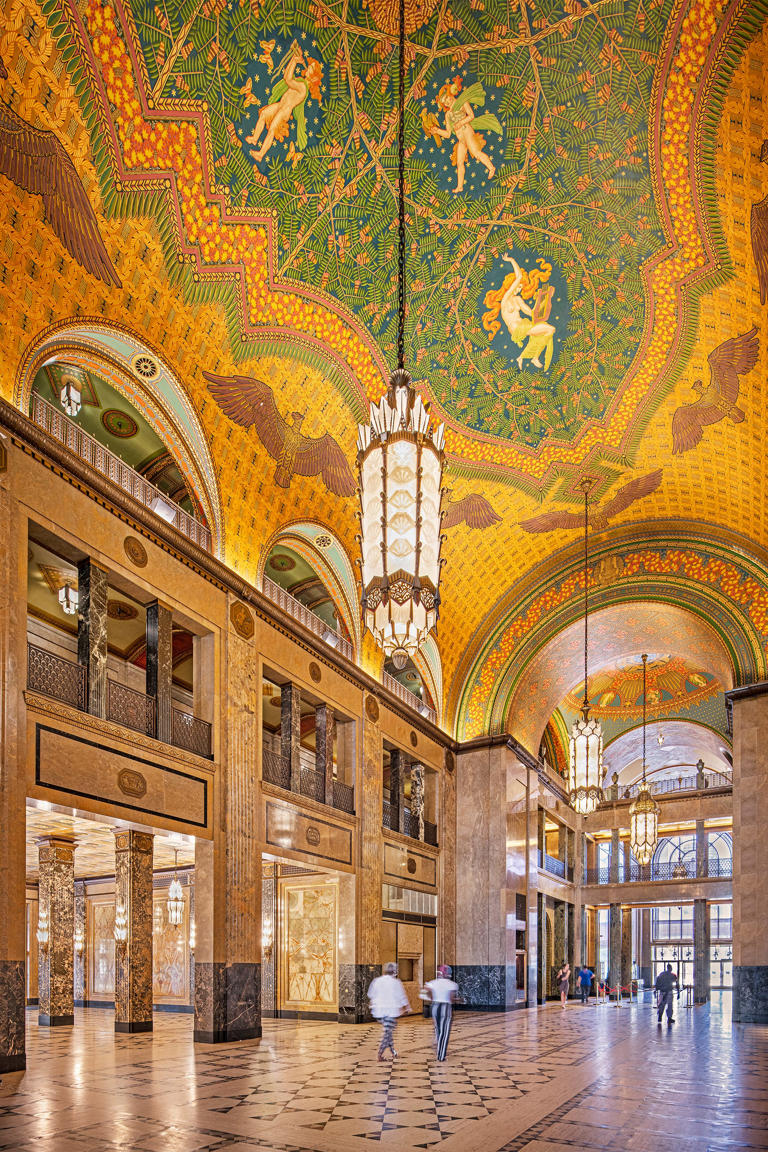

COMMENTS
The Fisher Building is Detroit's premier destination for office, retail, entertainment and events. Shop retailers, discover the building's history, and learn about office and retail space available for lease. ... marble and brass. Join a free tour offered by Pure Detroit. Explore Photos Book a Tour 3011 W. Grand Blvd. Detroit, MI 48202 313.874. ...
Pure Detroit Fisher Building Tours are currently running Saturdays at 11 am, 1 pm and 3 pm. Please see our Eventbrite page for more details. News & Updates SIGN UP TO FOLLOW UP ON NEW PURE DETROIT PRODUCTS, TOURS, AND EVENTS! PURE DETROIT LOCATIONS Pure Detroit has two storefronts in the city of Detroit. ...
Fisher Building. The building known as "Detroit's largest art object" has been dropping jaws in New Center for more than 90 years. The Fisher -- built by the Fisher brothers of "Body by Fisher" fame -- opened in September 1928, at Second Avenue and Grand Boulevard. Once known as the Cathedral to Commerce, the 441-foot tower is decked to ...
The Fisher building is considered to be the largest art object of Detroit, it is located on 3011 Grand Ave. in downtown Detroit. It was designed by Albert Khan in 1925, construction was completed in 1928.It was recently acquired by MSU (Michigan State University) and it is being currently rehabilitated.
By: Bill Buccalo. Take a step back in time to get an up close and personal look at the gorgeous Fisher Building. Pure Detroit offers free guided tours to of the iconic building from knowledgeable guides who share the Fisher family history, details on the construction project, Albert Kahns's 1928 Art Deco design, and what was "suppose to be ...
The Fisher Building is a landmark skyscraper located at 3011 West Grand Boulevard in the heart of the New Center area of Detroit, Michigan.The ornate 30-story building, completed in 1928, is one of the major works of architect Albert Kahn, and is designed in an Art Deco style, faced with limestone, granite, and several types of marble.The Fisher family financed the building with proceeds from ...
This tour is SOLD OUT. For wait list information, please call 313.833.1801.When the seven Fisher Brothers of Fisher Body fame hired architect Albert Kahn in 1927 to design a building that would bear their name, they gave him a blank check and the instructions to build "the most beautiful building in the world." Plans for a $35 million three-phase project were announced by the
Often cited as "Detroit's largest art object," the Fisher Building has brightened the skyline of Detroit since 1928. The building was the project of the seven Fisher Brothers, of Fisher Body prestige. Originally carriage-makers, the brothers popularized the closed body for the automobile which made year-round car travel possible.
A Saturday afternoon tour of Detroit's Fisher building. Overview of the building's amazing architecture.
Breaking ground on August 22nd of 1927, in front of crowd that included the Governor of Michigan and the Mayor of Detroit, the Fisher Building rose through the city's sky at an alarmingly rapid rate. The Building would be opened on September 1st, 1928 and would immediately gain recognition. The 441 ft. tower led to Albert Kahn being awarded ...
Tour the Incredible Fisher Building. This landmark skyscraper is located at 3011 West Grand Boulevard. So this is cool: Pure Detroit, located on the corner of Lothrop and Second on the first floor, offers FREE Tours (approximately 1 hour) of this magnificent Art Deco building erected in 1928. You will be wowed by stunning mosaic floors, breathtaking ceilings and even the elevator doors are ...
The tours obviously serve to promote the business, but more than that, they promote and honor the city and buildings that are such an integral part of that business. The three tours include a Downtown Skyscraper tour, and two interior tours, of the Fisher Building and the Guardian Building, both locations of a Pure Detroit shop.
Both tours were a part of the completely free public tour series that Pure Detroit began hosting this past February to help celebrate it's fifteen-year anniversary. (In addition to the Fisher Building tour and the Downtown Skyscraper tour, there is also a tour of the Guardian Building itself.) The tours obviously serve to promote Pure Detroit ...
Fisher Building Tour 3011 W Grand Blvd., Detroit, MI Best For: Little Kids 3-6; Big Kids 7-9; Tweens 10-12; Teens 13-17; Just as they do inside the Guardian downtown, Pure Detroit offers free 45-minute to 1 hour tours of the Fisher that will get you and your kids up close to the fresco paintings on the ceilings, provide you views of the city ...
Thousands of football fans and sports professionals descended on downtown Detroit over the weekend as the city hosted the 2024 NFL Draft. ... the building is one of the most haunted spots in Detroit and offers guided tours. Caroline Bologna/HuffPost. Views at the Fisher Building, cocktails at The Monarch Club and the exterior of Madcap Coffee ...
Holiday shopping and entertainment will come to the Fisher Building this weekend. The afternoon event will feature more than 20 vendors, performances and tours, marking Detroit's holiday season.
Pure Detroit also gives free tours. You can also shop and take in a show at the Fisher Theatre, although those'll cost you. Returning back along Woodward Avenue, the Detroit Public Library's ...